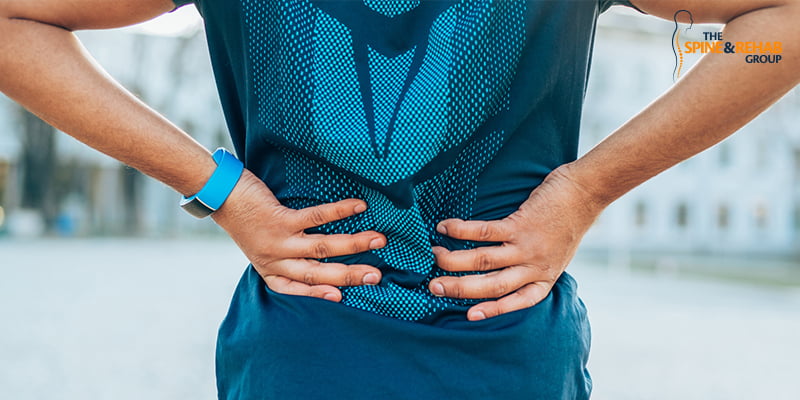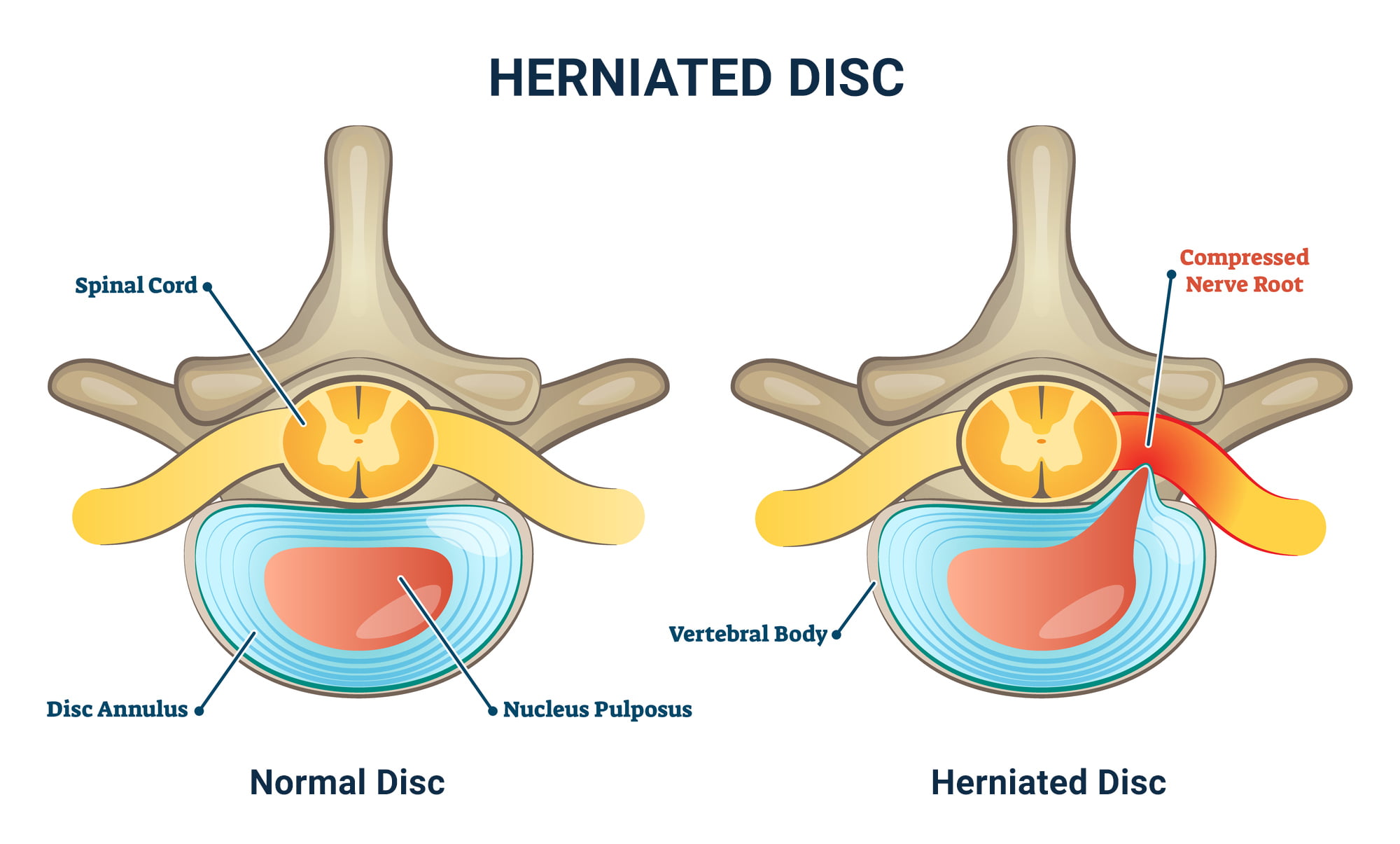 OUR LOCATIONS
Call to book 201.523.9590
OUR LOCATIONS
Call to book 201.523.9590
 OUR LOCATIONS
Call to book 201.523.9590
OUR LOCATIONS
Call to book 201.523.9590

Back pain is a common problem for many American adults. Thousands of patients seek out medical assistance for back-related concerns, with lower back pain cited as a top disability worldwide. There are many causes for back pain, some ranging from lifestyle to underlying conditions. In some cases, the misalignment of some muscles or nerves can lead to back pain.
But can a hernia cause back pain? While hernias can sometimes occur in areas near the back area, it’s actually herniated discs that cause the issue. Herniated discs occur when the soft inner layer overlaps with the outer ring. This leads to compression or pinching in the spinal nerves.
While the names of these conditions seem similar, they’re actually different. Hernias refer to the abnormal protrusion of an organ into an adjacent cavity. These typically occur in the abdominal area and may require surgery for connection. On the other hand, herniated discs occur in the vertebral columns. These often lead to back pain and can be corrected with therapy.
Hernias are the result of tissues or organs that puncture an adjacent cavity, leading to a painful and uncomfortable bulge along the affected area. These frequently appear in the abdominal area, with inguinal (groin) hernias being the most common.
Hernias are associated with pain or discomfort in the affected area. The pain may get worse when you cough, exercise, or urinate. For proper treatment, most people will need surgery to return the organ back to its proper alignment.
Herniated or slipped discs are similarly named due to the “bulging” that occurs between the inner and outer rings of the vertebral disks. These disks provide cushion to the vertebrae, allowing them to the inner and outer rings. These intervertebral disks serve as a cushion between each vertebra, preventing them from colliding with one another. Each disc has 2 parts: the annulus fibrosus (inner ring) and the nucleus pulposus (outer layer).
In a herniated disc, the inner ring bulges out and a part of it protrudes through the outer ring. The protrusion can affect other structures surrounding the vertebrae. Herniated discs often press into nerves, leading to back and leg pain.
Hernias can occur at any age, although it’s most common in adults who have physically demanding jobs. Improper lifting of heavy machinery is the top cause of inguinal hernias, alongside hard coughs, heavy blows to the stomach, and improper posture.
Herniated disks are most common in aging populations. Degeneration of the disk is the most common cause of herniation, and is associated with aging. Genetics has also been found to play a part in slipped discs.
Additionally, having improper form during workouts and living sedentary lifestyles are considered risk factors. Many professional athletes suffer from herniated discs due to the repetitive flexion movements in some sports. Obese people also have a higher chance of developing slipped discs.
Hernias are diagnosed by x-rays and other imaging tests. Your specialist may order an ultrasound to further pinpoint the location of the hernia. The results will then be cross-checked with your medical history. You may also be asked to undergo a physical examination.
Herniated disc diagnosis is done through a combination of physical examinations and spinal imaging. Your doctor will first ask you about your symptoms and previous medical conditions. The physical exam aims to rule out other causes of pain, such as tumors and lesions. You might also be asked to perform a straight leg raise, where the leg will be lifted while you’re sitting.

Herniated discs are an established cause of back pain. Spinal disc herniation can occur along any part of your spine, but the lower back is most susceptible. The slipped disc can pinch the nerves and compress the muscles in the area and lead to radiating pain.
Most symptoms associated with herniated discs are related to pain. The common symptom among all patients is pain along the back. This may be accompanied by numbness or tingling sensations. In some patients, the pain can radiate to the arms and legs. The pain can also get worse with certain movements, such as standing and sitting.
If left untreated, herniated discs can lead to difficulty walking. You may also experience muscle weakness, making it difficult to perform daily tasks or light work. If the herniation gets worse, you may also lose control of certain muscles.
Due to its association with aging, it may be impossible to prevent a herniated disc. However, you can make some lifestyle changes to minimize the chances of developing a slipped disc. It’s important to maintain a proper posture to prevent wearing out your spine.
You should also ensure that all lifting movements are done with proper form. Bend and lift using your knees, and avoid placing the weight onto the waist. This leads to disc degeneration and other back injuries. If you have a desk job, it’s also important to take frequent breaks from sitting. Getting up to stretch or walk every hour can help relieve stress and tension.
You may also look into exercises that strengthen the back muscles. Some yoga poses and stretches are associated with better back health. Maintaining a healthy weight is another way to minimize your risk for herniation, since obesity is a risk factor.
To get short-term pain relief, it may be helpful to use a warm or cold compress. You can also take over-the-counter pain medications like Tylenol. These won’t solve the underlying problems, but they can give you instant relief.
You should also avoid lifting heavy weights until you can get treatment. However, it’s important to stay as active as possible to prevent further muscle weakness or stiffness. Low-impact exercises like walking and yoga can benefit the back muscles.
When it comes to treating herniated discs, a multi-disciplinary approach can be beneficial. Non-surgical therapies, such as interventional injections, acupuncture, and physical therapy can help you recover at a faster rate. The team at The Spine and Rehab Group has served thousands of clients with safe and effective treatments.
Interventional spine and pain injections help minimize pain and inflammation and pain by targeting the affected discs. Specialists may use epidural steroid injections to help you move more freely. Your doctor may order multiple cycles of injection if your body responds well to the steroid. Additionally, radiofrequency treatments can complement injections in the lumbar area.
Medical massages are a component of many physical treatment plans. But besides that, they can also be used to treat localized pain in the back. The massage therapist will target key areas and pressure points associated with pain.
A fixture of Chinese traditional medicine, acupuncture uses tiny needles to reach trigger points and release endorphins into the body. The procedure is painless, with the fine needles measuring around 0.5 to 2.5 inches. Your acupuncturist will typically refer to a reflexology map marking the points corresponding to the spine.
To rule out cancers and other malignancies, your doctor may use electromyography (EMG). An EMG evaluates the muscles and nerves around the area with acute pain. The EMG is useful in locating the origin point of the herniated disc, especially if it’s in a deeper region.
Considered a pillar of rehabilitative medicine, physical therapy combines patient education, manual therapy, and exercises. These help you regain your strength to perform daily activities and return to work. All physical therapy treatment plans are tailored to fit the patient’s needs and goals.
Having a treatment plan that caters to a patient’s needs is a crucial part of recovery. There’s not a single way to treat herniated discs, and you may benefit from evaluating all your options. While acupuncture can help with pain relief, physical therapy is more focused on long-term recovery. Steroid injections also make a compelling case for their convenience.
But whatever treatment you choose, The Spine and Rehab Group can help you ease into it. We have a team of licensed therapists and doctors skilled in acupuncture, physical therapy, and medicine. Thousands of clients in New York and New Jersey have given us 5-star reviews, and we’ve received Castle Connolly’s Top Doctors awards for 7 years straight. You may visit our pain center or call us at 201-523-9590 to book an appointment.



